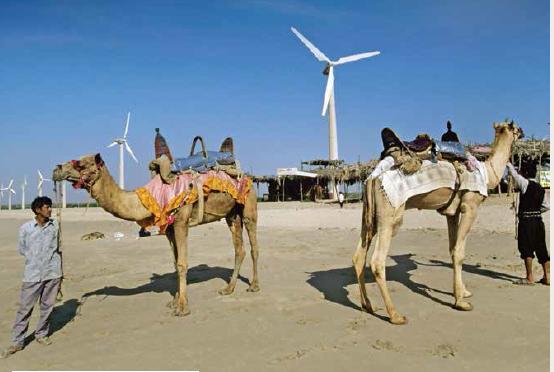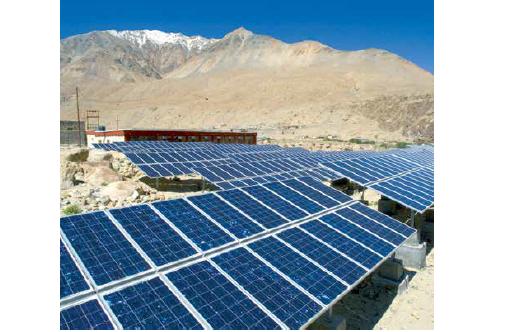Power is one of the most critical components of infrastructure crucial for the economic growth and welfare of nations. The existence and development of adequate infrastructure is essential for sustained growth of the Indian economy. India’s power sector is one of the most diversified in the world. Sources of power generation range from conventional sources such as coal, lignite, natural gas, oil, hydro and nuclear power to viable non-conventional sources such as wind, solar, and agricultural and domestic waste.
Electricity demand in the country has increased rapidly and is expected to rise further in the years to come. In order to meet the increasing demand for electricity in the country, massive addition to the installed generating capacity is required. India ranks third, just behind US and China, among 40 countries with renewable energy focus, on back of strong focus by the government on promoting renewable energy and implementation of projects in a time bound manner.
MARKET SIZE
Indian power sector is undergoing a significant change that has redefined the industry outlook. Sustained economic growth continues to drive electricity demand in India. The Government of India’s focus on the capacity addition in the country. At the same time, the competitive intensity is increasing at both the market and supply sides (fuel, logistics, finances, and manpower). The idea of “Power for all” should be observed in a deeper perspective, together with the incentive “Digital India”, and then you can grasp the size of the change that is happening in this vast and populated country. Total capacity of renewable energy plants in India stood at 42,850 megawatts as on 30th April 2016, thereby surpassing the 42,783 megawatts capacity of large hydroelectricity projects in the country. Cumulative solar installations in India crossed the 7.5 gigawatt (GW) mark in May 2016, about 2.2 GW more than all of the solar installations in 2015. The Planning Commission’s 12th Five-Year Plan estimates total domestic energy production to reach 669.6 Million Tonnes of Oil Equivalent (MTOE) by 2016–17 and 844 MTOE by 2021–22. As of January 2016, total thermal installed capacity stood at 200.74 Gigawatt (GW), while hydro (renewable) energy installed capacity totaled 42.66 GW. At 5.78 GW, nuclear energy capacity remained broadly constant compared with the previous year. India’s rooftop solar capacity addition grew 66 per cent from last year to reach 525 Mega Watts (MW), and has the potential to grow up to 6.5 Giga watts (GW)! India’s wind power capacity, installed in FY2016, is estimated to increase 20 per cent over last year led by favourable policy support that has encouraged
both independent power producers (IPP) and non-IPPs. India is expected to add nearly 4,000 Megawatts (MW) of solar power in 2016, nearly twice the addition of 2,133 MW in 2015.

GOVERNMENT INITIATIVES
The Government of India has identified power sector as a key sector of focus so as to promote sustained industrial growth. Some initiatives by the Government of India to boost the Indian power sector:
• The Government of India plans to set up a trading platform for clean energy, which will be jointly developed by the Ministry
of New and Renewable Energy (MNRE) and Power Trading Corporation of India (PTC), to help states buy, sell and trade renewable-based power.
• Mr Piyush Goyal, Minister of State (Independent Charge) for Power, Coal, New and Renewable Energy, has stated that the
Government of India has set a target to electrify all un-electrified villages in the country by the end of 2016 and to provide electricity to every home in India by 2020
• The Government of India plans to start as many as 10,000 solar, wind and biomass power projects in next five years, with an average capacity of 50 kilowatt per project, thereby adding 500 megawatt to the total installed capacity. Government also asked states to prepare action plans with yearwise targets to introduce renewable energy
technologies and install solar rooftop panels so that the states complement government’s works to achieve 175 Gigawatts of renewable power by 2022.
• The Ministry of New and Renewable Energy (MNRE) has outlined new guidelines which allow state government to use its unproductive
and non-agricultural land for solar parks, thereby minimising the use of private land and reducing the problems faced and costs incurred for land acquisition for solar park projects.
• The Government of India plans to auction large sized hydropower projects, similar to the auction of Ultra Mega Power Projects (UMPPs) for thermal power plants of capacity 4,000 megawatt (MW) in Sasan in Madhya Pradesh and Mundra in Gujarat, which have been setup in a cost effective manner.
• The Ministry of New & Renewable Energy is implementing two national level programmes, namely Grid Connected Rooftop & Small Solar Power Plants Programme and Off-Grid & Decentralised Solar
Applications, in order to promote installation of solar rooftop systems, as per Mr Piyush Goyal, Minister of State (Independent
Charge) for Power, Coal & New and Renewable Energy.
• The Union Cabinet of India approved 15,000 MW of rid-connected solar power projects of National Thermal Power Corp Ltd (NTPC).
